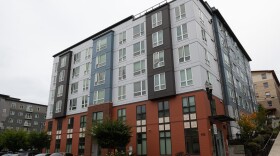Pierce County’s Unified Regional Approach (URA) to homelessness officially kicked off, but it is still unclear how the coalition will be led, what goals it will attempt to achieve and how it will operate.
On March 7, dozens of elected officials from cities in Pierce County, representatives from local government agencies and some nonprofit service providers gathered for the official URA meeting.
The Unified Regional Approach is an attempt to satisfy the first goal identified in Pierce County’s Comprehensive Plan to End Homelessness — established by the Pierce County Council four years ago.
Attendees included members of the Tacoma City Council, City of Gig Harbor, Lakewood City Council, Puyallup City Council, local fire and police departments, Pierce County Council members and Pierce County Human Services, among others.
The URA is intended to bring together government, community and non-profit partners involved with the region’s response to the homelessness crisis. The idea is that better coordination and cooperation is needed between jurisdictions and communities fighting the common problem of homelessness.
The effort to assemble the first URA meeting has been long and costly. Last year, Pierce County offered $1 million to a consulting firm to help organize and implement the URA.
During the March 7 meeting, those consultants facilitated the conversation.
Brian Scott is the project director from Uncommon Bridges, the consulting firm chosen by the county.
Scott outlined the plan to slowly define the objectives of the URA, the roles each member would have and how it would operate. He said the members of the URA would have to discuss and determine their respective levels of commitment and how decisions about resources would be made.
Even questions around how often the URA would meet have yet to be answered.
That process alone is expected to take a year.
Scott said consultants would speak individually with members of the URA to ask about their thoughts, concerns and expectations for the URA. He said the intention is to collect feedback that members are hesitant to share during meetings.
Some of the early feedback the consultants received about the homelessness response system was shared March 7. The themes included unequal burden faced by certain jurisdictions that provide the majority of the homeless services, a need for better data tracking and sharing, and “cumbersome processes” for procuring and distributing contracts and grant funding.
Consultants also identified tensions between jurisdictions due to factors such as smaller communities having fewer resources to contribute, confusion around leadership roles, and regional approaches that could undermine local strategies and priorities.
Sarah Solon works for HR&A, a consulting firm partnering with Uncommon Bridges to help implement the URA.
Solon presented case studies of other regions that improved their response to homelessness through regional coordination.
According to data she presented, Harris County, Texas, where Houston is located, had the sixth largest homeless population in the nation in 2011. Since 2012, the region has been able to reduce its unhoused population by 60%.
Solon said it found success by creating a unified system where anyone experiencing homelessness was able to access services and support. She said the system focused heavily on reducing wasted and duplicated efforts.
According to her data, the region housed 32,000 people since 2012 and experienced a 90% success rate in housing programs —meaning those individuals did not return to homelessness over two years.
She told the attendees some of the key agreements regional coalitions could make include operational coordination, service contract alignments and data-sharing agreements. She also outlined a need for an alignment of financial resources and stronger coordination to request state and federal funding.
“What is happening here is not happening in other communities,” she encouraged.
“We are on the wave of innovation.”
This article was first published by the Tacoma News Tribune through the Murrow News Fellow program, managed by Washington State University.






